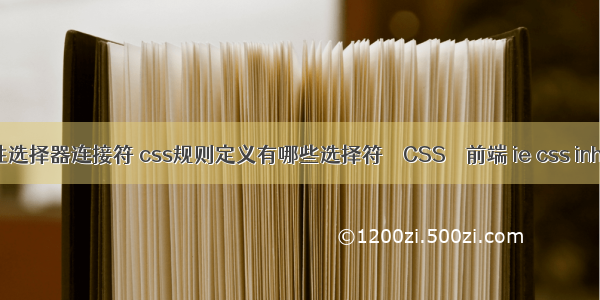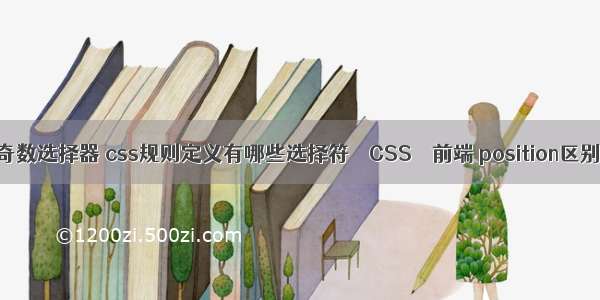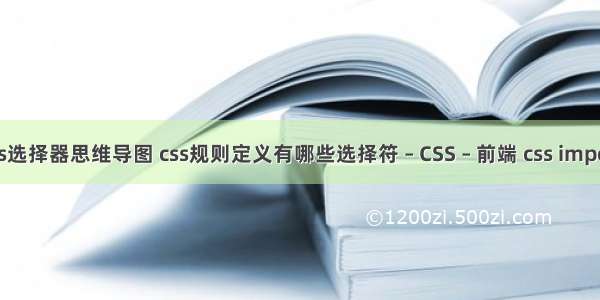
1、通配选择符( * ):匹配任意元素。
2、id选择符( # myid):匹配 ID 等于“myid”的任意元素 。
3、类选择符(.myclassname):匹配 class 等于“myclassname”的任意元素.
4、标签选择符(div, h1, p):选择指定元素名称的所有元素。
5、相邻选择符(E + F):用于选择(不是内部)指定的第一个元素之后紧跟的元素。
6、子选择符(E > F):用于选取带有特定父元素的元素,例ul > li,选择所有父级是 <ul> 元素的每个 <li> 元素。(学习视频分享:css视频教程)
7、后代选择符(E F):用于选取元素内部的元素。
8、伪类和伪元素选择符:用于向某些选择器添加特殊的效果。
@ css的命名规则?
一、网页制作中规范使用DIV+CSS命名规则,可以改善优化功效特别是团队合作时候可以提供合作制作效率。
所有的命名最好都小写
属性的值一定要用双引号("")括起来,且一定要有值如class="DIVcss",id="divcss"
每个标签都要有开始和结束,且要有正确的层次,排版有规律工整
空元素要有结束的tag或于开始的tag后加上"/"
表现与结构完全分离,代码中不涉及任何的表现元素,如style、font、bgColor、border等
<h1>到<h5>的定义,应遵循从大到小的原则,体现文档的结构,并有利于搜索引擎的查询。
给每一个表格和表单加上一个唯一的、结构标记id
给图片加上alt标签
尽量使用英文命名原则
尽量不缩写,除非一看就明白的单词
二、相对网页外层重要部分CSS样式命名:
外套 wrap —————-用于最外层
头部 header ————–用于头部
主要内容 main ————用于主体内容(中部)
左侧 main-left ————左侧布局
右侧 main-right ———–右侧布局
导航条 nav —————–网页菜单导航条
内容 content —————用于网页中部主体
底部 footer —————–用于底部
DIV+CSS命名小结:
无论是使用“.”(小写句号)选择符号开头命名,还是使用“#”(井号)选择符号开头命名都无所谓,但大家最好遵循。
主要的、重要的、特殊的、最外层的盒子用“#”(井号)选择符号开头命名,其它都用“.”(小写句号)选择符号开头命名,同时考虑命名的CSS选择器在HTML中重复使用调用。
通常大家最常用主要命名有:
wrap(外套、最外层)、header(页眉、头部)、nav(导航条)、menu(菜单)、title(栏目标题、一般配合h1\h2\h3\h4标签使用)
、content (内容区)、footer(页脚、底部)、logo(标志、可以配合h1标签使用)、banner(广告条,一般在顶部)、copyRight(版权)。
@ 怎么使用CSS让图片水平垂直都居中?
了解 CSS 中属性的值及其特性, 透彻分析问题和需求才可以选择和设计最适合的布局解决方案。
居中布局
水平居中
子元素于父元素水平居中且其(子元素与父元素)宽度均可变。
inline-block + text-align
<div class=”parent”>
<div class=”child”>Demo</div>
</div>
<style>
.child {
display: inline-block;
}
.parent {
text-align: center;
}
</style>
优点
兼容性佳(甚至可以兼容 IE 6 和 IE 7)
table + margin
<div class=”parent”>
<div class=”child”>Demo</div>
</div>
<style>
.child {
display: table;
margin: 0 auto;
}
</style>
NOTE: display: table 在表现上类似 block 元素,但是宽度为内容宽。
优点
无需设置父元素样式 (支持 IE 8 及其以上版本)
NOTE:兼容 IE 8 一下版本需要调整为 <table> 的结果
absolute + transform
<div class=”parent”>
<div class=”child”>Demo</div>
</div>
<style>
.parent {
position: relative;
}
.child {
position: absolute;
left: 50%;
transform: translateX(-50%);
}
</style>
优点
绝对定位脱离文档流,不会对后续元素的布局造成影响。
缺点
transform 为 CSS3 属性,有兼容性问题
flex + justify-content
<div class=”parent”>
<div class=”child”>Demo</div>
</div>
<style>
.parent {
display: flex;
justify-content: center;
}
/* 或者下面的方法,可以达到一样的效果 */
.parent {
display: flex;
}
.child {
margin: 0 auto;
}
</style>
优点
只需设置父节点属性,无需设置子元素
缺点
有兼容性问题
垂直居中
子元素于父元素垂直居中且其(子元素与父元素)高度均可变。
table-cell + vertical-align
<div class=”parent”>
<div class=”child”>Demo</div>
</div>
<style>
.parent {
display: table-cell;
vertical-align: middle;
}
</style>
优点
兼容性好(支持 IE 8,以下版本需要调整页面结构至 table)
absolute + transform
<div class=”parent”>
<div class=”child”>Demo</div>
</div>
<style>
.parent {
position: relative;
}
.child {
position: absolute;
top: 50%;
transform: translateY(-50%);
}
</style>
优点
绝对定位脱离文档流,不会对后续元素的布局造成影响。但如果绝对定位元素是唯一的元素则父元素也会失去高度。
缺点
transform 为 CSS3 属性,有兼容性问题
flex + align-items
<div class=”parent”>
<div class=”child”>Demo</div>
</div>
<style>
.parent {
display: flex;
align-items: center;
}
</style>
优点
只需设置父节点属性,无需设置子元素
缺点
有兼容性问题
水平与垂直居中
子元素于父元素垂直及水平居中且其(子元素与父元素)高度宽度均可变。
inline-block + text-align + table-cell + vertical-align
<div class=”parent”>
<div class=”child”>Demo</div>
</div>
<style>
.parent {
text-align: center;
display: table-cell;
vertical-align: middle;
}
.child {
display: inline-block;
}
</style>
优点
兼容性好
absolute + transform
<div class=”parent”>
<div class=”child”>Demo</div>
</div>
<style>
.parent {
position: relative;
}
.child {
position: absolute;
left: 50%;
top: 50%;
transform: translate(-50%, -50%);
}
</style>
优点
绝对定位脱离文档流,不会对后续元素的布局造成影响。
缺点
transform 为 CSS3 属性,有兼容性问题
flex + justify-content + align-items
<div class=”parent”>
<div class=”child”>Demo</div>
</div>
<style>
.parent {
display: flex;
justify-content: center;
align-items: center;
}
</style>
优点
只需设置父节点属性,无需设置子元素
缺点
有兼容性问题
多列布局
多列布局在网页中非常常见(例如两列布局),多列布局可以是两列定宽,一列自适应, 或者多列不定宽一列自适应还有等分布局等。
一列定宽,一列自适应
float + margin
<div class=”parent”>
<div class=”left”>
<p>left</p>
</div>
<div class=”right”>
<p>right</p>
<p>right</p>
</div>
</div>
<style>
.left {
float: left;
width: 100px;
}
.right {
margin-left: 100px
/*间距可再加入 margin-left */
}
</style>
NOTE:IE 6 中会有3像素的 BUG,解决方法可以在 .left 加入 margin-left:-3px。
float + margin + (fix) 改造版
<div class=”parent”>
<div class=”left”>
<p>left</p>
</div>
<div class=”right-fix”>
<div class=”right”>
<p>right</p>
<p>right</p>
</div>
</div>
</div>
<style>
.left {
float: left;
width: 100px;
}
.right-fix {
float: right;
width: 100%;
margin-left: -100px;
}
.right {
margin-left: 100px
/*间距可再加入 margin-left */
}
</style>
NOTE:此方法不会存在 IE 6 中3像素的 BUG,但 .left 不可选择, 需要设置 .left {position: relative} 来提高层级。 此方法可以适用于多版本浏览器(包括 IE6)。缺点是多余的 HTML 文本结构。
float + overflow
<div class=”parent”>
<div class=”left”>
<p>left</p>
</div>
<div class=”right”>
<p>right</p>
<p>right</p>
</div>
</div>
<style>
.left {
float: left;
width: 100px;
}
.right {
overflow: hidden;
}
</style>
设置 overflow: hidden 会触发 BFC 模式(Block Formatting Context)块级格式化文本。 BFC 中的内容与外界的元素是隔离的。
优点
样式简单
缺点
不支持 IE 6
table
<div class=”parent”>
<div class=”left”>
<p>left</p>
</div>
<div class=”right”>
<p>right</p>
<p>right</p>
</div>
</div>
<style>
.parent {
display: table;
width: 100%;
table-layout: fixed;
}
.left {
display: table-cell;
width: 100px;
}
.right {
display: table-cell;
/*宽度为剩余宽度*/
}
</style>
table 的显示特性为每列的单元格宽度合一定等与表格宽度。 table-layout: fixed; 可加速渲染,也是设定布局优先。
NOTE:table-cell 中不可以设置 margin 但是可以通过 padding 来设置间距。
flex
<div class=”parent”>
<div class=”left”>
<p>left</p>
</div>
<div class=”right”>
<p>right</p>
<p>right</p>
</div>
</div>
<style>
.parent {
display: flex;
}
.left {
width: 100px;
margin-left: 20px;
}
.right {
flex: 1;
/*等价于*/
/*flex: 1 1 0;*/
}
</style>
NOTE:flex-item 默认为内容宽度。
缺点
低版本浏览器兼容问题
性能问题,只适合小范围布局。
两列定宽,一列自适应
<div class=”parent”>
<div class=”left”>
<p>left</p>
</div>
<div class=”center”>
<p>center<p>
</div>
<div class=”right”>
<p>right</p>
<p>right</p>
</div>
</div>
<style>
.left, .center {
float: left;
width: 100px;
margin-right: 20px;
}
.right {
overflow: hidden;
/*等价于*/
/*flex: 1 1 0;*/
}
</style>
多列定宽的实现可以更具单列定宽的例子进行修改与实现。
一列不定宽加一列自适应
不定宽的宽度为内容决定,下面为可以实现此效果的方法:
float + overflow,此方法在 IE6 中有兼容性问题
table,此方法在 IE6 中有兼容性问题
flex,此方法在 IE9及其以下版本中有兼容性问题
多列不定宽加一列自适应
其解决方案同一列不定宽加一列自适应相仿。
多列等分布局
每一列的宽度和间距均相等,下面为多列等分布局的布局特定。
父容器宽度为 C,C = W * N + G * N – G => C + G = (W + G) * N。
float
<div class=”parent”>
<div class=”column”>
<p>1</p>
</div>
<div class=”column”>
<p>2</p>
</div>
<div class=”column”>
<p>3</p>
</div>
<div class=”column”>
<p>4</p>
</div>
</div>
<style media=”screen”>
.parent {
margin-left: -20px;
}
.column {
float: left;
width: 25%;
padding-left: 20px;
box-sizing: border-box;
}
</style>
NOTE:此方法可以完美兼容 IE8 以上版本。 NOTE+:此方法结构和样式具有耦合性。
table
<div class=’parent-fix’>
<div class=”parent”>
<div class=”column”>
<p>1</p>
</div>
<div class=”column”>
<p>2</p>
</div>
<div class=”column”>
<p>3</p>
</div>
<div class=”column”>
<p>4</p>
</div>
</div>
</div>
<style media=”screen”>
.parent-fix {
margin-left: -20px;
}
.parent {
display: table;
width: 100%;
/*可以布局优先,也可以单元格宽度平分在没有设置的情况下*/
table-layout: fixed;
}
.column {
display: table-cell;
padding-left: 20px;
}
</style>
NOTE:缺点是多了文本结果
flex
<div class=”parent”>
<div class=”column”>
<p>1</p>
</div>
<div class=”column”>
<p>2</p>
</div>
<div class=”column”>
<p>3</p>
</div>
<div class=”column”>
<p>4</p>
</div>
</div>
<style media=”screen”>
.parent {
display: flex;
}
.column {
/*等价于 flex: 1 1 0;*/
flex: 1;
}
.column+.column {
margin-left: 20px;
}
</style>
NOTE:flex 的特性为分配剩余空间。 NOTE+:兼容性有问题。
table
table 的特性为每列等宽,每行等高可以用于解决此需求。
<div class=”parent”>
<div class=”left”>
<p>left</p>
</div>
<div class=”right”>
<p>right</p>
<p>right</p>
</div>
</div>
<style>
.parent {
display: table;
width: 100%;
table-layout: fixed;
}
.left {
display: table-cell;
width: 100px;
}
.right {
display: table-cell;
/*宽度为剩余宽度*/
}
</style>
flex
<div class=”parent”>
<div class=”left”>
<p>left</p>
</div>
<div class=”right”>
<p>right</p>
<p>right</p>
</div>
</div>
<style>
.parent {
display: flex;
}
.left {
width: 100px;
margin-left: 20px;
}
.right {
flex: 1;
/*等价于*/
/*flex: 1 1 0;*/
}
</style>
NOTE:flex 默认的 align-items 的值为 stretch。
float
<div class=”parent”>
<div class=”left”>
<p>left</p>
</div>
<div class=”right”>
<p>right</p>
<p>right</p>
</div>
</div>
<style>
.parent {
overflow: hidden;
}
.left,
.right {
padding-bottom: 9999px;
margin-bottom: -9999px;
}
.left {
float: left;
width: 100px;
margin-right: 20px;
}
.right {
overflow: hidden;
}
</style>
NOTE:此方法为伪等高(只有背景显示高度相等),左右真实的高度其实不相等。 NOTE+:此方法兼容性较好。
全屏布局
例如管理系统,监控与统计平台均广泛的使用全屏布局。
定宽需求
实现方案
Position 常规方案
Flex CSS3 新实现
Position
<div class=”parent”>
<div class=”top”></div>
<div class=”left”></div>
<div class=”right”>
/*辅助结构用于滚动*/
<div class=”inner”></div>
</div>
<div class=”bottom”></div>
</div>
<style>
html,
body,
.parent {
height: 100%;
/*用于隐藏滚动条*/
overflo: hidden;
}
.top {
/*相对于 body 定位*/
position: absolute;
top: 0;
left: 0;
right: 0;
height: 100px;
}
.left {
position: absolute;
left: 0;
top: 100px;
bottom: 50px;
width: 200px;
}
.right {
position: absolute;
left: 200px;
right: 0;
top: 100px;
bottom: 50px;
overflow: auto;
}
.right .inner {
/*此样式为演示所有*/
min-height: 1000px;
}
.bottom {
position: absolute;
left: 0;
right: 0;
bottom: 0;
height: 50px;
}
</style>
Position 兼容
此方法不支持 IE6 可以使用下面的方法解决兼容问题。
<div class=”g-hd”></div>
<div class=”g-sd”></div>
<div class=”g-mn”></div>
<div class=”g-ft”></div>
<style>
html,
body {
width: 100%;
height: 100%;
overflow: hidden;
margin: 0;
}
html {
_height: auto;
_padding: 100px 0 50px;
}
.g-hd,
.g-sd,
.g-mn,
.g-ft {
position: absolute;
left: 0;
}
.g-hd,
.g-ft {
width: 100%;
}
.g-sd,
.g-mn {
top: 100px;
bottom: 50px;
_height: 100%;
overflow: auto;
}
.g-hd {
top: 0;
height: 100px;
}
.g-sd {
width: 300px;
}
.g-mn {
_position: relative;
left: 300px;
right: 0;
_top: 0;
_left: 0;
_margin-left: 300px;
}
.g-ft {
bottom: 0;
height: 50px;
}
</style>
Flex
<div class=”parent”>
<div class=”top”></div>
<div class=”middle”>
<div class=”left”></div>
<div class=”right”>
<div class=”inner”></div>
</div>
</div>
<div class=”bottom”></div>
</div>
<style media=”screen”>
html,
body,
parent {
height: 100%;
overflow: hidden;
}
.parent {
display: flex;
flex-direction: column;
}
.top {
height: 100px;
}
.bottom {
height: 50px;
}
.middle {
// 居中自适应
flex: 1;
display: flex;
/*flex-direction: row 为默认值*/
}
.left {
width: 200px;
}
.right {
flex: 1;
overflow: auto;
}
.right .inner {
min-height: 1000px;
}
</style>
Flex 兼容性
CSS3 中的新概念所有 IE9 及其也行版本都不兼容。
百分比宽度需求
只需把定宽高(px 为单位的值)的实现改成百分比(%)既可。
内容自适应
只有右侧栏占据剩余位置,其余空间均需根据内容改变。 所以 Postion 的定位方法不适合实现此方案。下面列出了两种布局方案:
Flex
Grid,W3C 草案并不稳定,浏览器支持也并不理想
Flex
只有不为宽高做出限制,既可对其中的内容做出自适应的布局。
<div class=”parent”>
<div class=”top”></div>
<div class=”middle”>
<div class=”left”></div>
<div class=”right”>
<div class=”inner”></div>
</div>
</div>
<div class=”bottom”></div>
</div>
<style media=”screen”>
html,
body,
parent {
height: 100%;
overflow: hidden;
}
.parent {
display: flex;
flex-direction: column;
}
.middle {
// 居中自适应
flex: 1;
display: flex;
/*flex-direction: row 为默认值*/
}
.right {
flex: 1;
overflow: auto;
}
.right .inner {
min-height: 1000px;
}
</style>
方案比较
方案兼容性性能自适应Position好好部分自适应Flex较差差可自适应Grid差较好可自适应
来自于头条,这个头条很厉害整理的很多~
@ 类和标签的区别?
选择器的种类可以分为三种:标签名选择器、类选择器和ID选择器。类选择器和标签名选择器的不同,类选择器是自己定义的,如class="aaa";标签名选择器是html已经规定好的标签名,如a标签是链接,h1是标题,img是图片,它们有默认的一些样式














